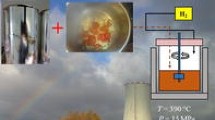Abstract
Most of the resources used for energy have a fossil origin and they are non-renewable materials. Using mixtures of waste materials with the currently used non-renewable materials can improve the renewability of the energy production. The goal of this work was to explore the effect of waste tire addition on a hydrovisbreaking process at low temperature. Four tests were carried out at 300 °C in H2 with different feedstocks: (1) vacuum residue; (2) tires; (3) 37.5wt% tires + 62.5wt% vacuum residue; (4) 15wt% tires + 85wt% vacuum residue. Dynamic viscosity, simulated distillation, density, elemental analysis (C, H, N, S% content) by ICP and analysis of gaseous products by GC–MS were carried out for all products. Content of insoluble compounds in hexane was estimated for the products from test (1) and vacuum residue. TGA analyses of the tires were carried out. The addition of tires to the vacuum residue brought a positive effect to increasing the yield of lighter products in the final liquid product. Densities and composition determinated by elemental analyses were similar for feedstock and products. The dynamic viscosity (60 °C) decreased from 24,550 to 17,700 mPa s for test (1) and to 1640 mPa s for test (3).




Similar content being viewed by others
Change history
24 January 2017
An erratum to this article has been published.
References
Armarego WLF, Perrin DD (1996) Purification of laboratory chemicals, 4th edn. Butterworth-Heinemann, Oxford
ASTM International (2010) ASTM standard: Standard test methods for instrumental determination of carbon, hydrogen, and nitrogen in petroleum products and lubricants. ASTM D5291, West Conshohocken, PA, USA
Austruy F, Tileuberdi Y, Ongarbaev Y, Mansurov Z (2012) Eurasian Chem Tech J 14:133–138. doi:10.1201/b19346-38
Benito AM, Martinez MT, Fernandez I, Miranda JL (1995) Visbreaking of an asphaltenic coal residue. Fuel 74(6):922–927. doi:10.1016/0016-2361(95)00013-U
Carrillo JA, Corredor LM (2013) Upgrading of heavy crude oils: Castilla. Fuel Process Technol 109:156–162. doi:10.1016/j.fuproc.2012.09.059
CEN (2010) European standard: Bitumen and bituminous binders. Determination of dynamic viscosity of bituminous binder using a rotating spindle apparatus. EN 13220:2010. Brussels, Belgium
Choi BC, Gross B, Malladi M (1986) Patent US4615791 A, Mobil Oil Corporation
Formela K, Klein M, Colom X, Saeb MR (2016) Investigating the combined impact of plasticizer and shear force on the efficiency of low temperature reclaiming of ground tire rubber (GTR). Polym Degrad Stab 125:1–11. doi:10.1016/j.polymdegradstab.2015.12.022
Forrest M (2014) Recycling and re-use of waste rubber. Smithers Rapra, Shawbury
Garcia PS, de Sousa FDB, de Lima JA, Cruz SA, Scuracchio CH (2015) Devulcanization of ground tire rubber: physical and chemical changes after different microwave exposure times. Express Polym Lett 9(11):1015–1026. doi:10.3144/expresspolymlett.2015.91
Gray RM (1994) Upgrading petroleum residues and heavy oils. Marcel Dekker, New York
Hidalgo-Herrador JM, Vráblík A, Jíša P, Černý R, Hamerníková J (2015) Chem Pap 69:1075–1083. doi:10.1515/chempap-2015-0119
Hossain M, Kitaguchi T, Sato Y, Tago T, Masuda T (2010) Heavy oil upgrading in supercritical water using iron based catalyst. 20th Annual Saudi-Japan Symposium. King Fahd University of Petroleum and Minerals, Research Institute - Annual catalysts in petroleum refining and petrochemicals symposium papers, pp 54–58
Joshi JB, Pandit AB, Kataria KL, Kulkarni RP, Sawarkar AN, Tandon D, Ram Y, Kumar MM (2008) Petroleum residue upgradation via visbreaking: a review. Ind Eng Chem Res 47:8960–8988. doi:10.1021/ie0710871
Lee SH, Heo HS, Jeong KE, Yim JH, Jeon JK, Jung KY, Ko YS, Kim SS, Park YK (2011) Catalytic pyrolysis of oilsand bitumen over nanoporous catalysts. J Nanosci Nanotechnol 11:759–762. doi:10.1166/jnn.2011.3232
Liu Y, Gao L, Wen L, Zong B (2009) Recent advances in heavy oil hydroprocessing technologies. Recent Patents Chem Eng 2:22–36. doi:10.2174/10022.5
Menoufy MF, Ahmed HS, Betiha MA, Sayed MA (2014) A Comparative study on hydrocracking and hydrovisbreaking combination for heavy vacuum residue conversion. Fuel 119:106–110. doi:10.1016/j.fuel.2013.11.017
Moretti E, Storaro L, Chessa G, Talon A, Callone E, Mueller KJ, Enrichi F, Lenarda M (2012) Stepwise dansyl grafting on the kaolinite interlayer surface. J Colloid Interface Sci 375:112–117. doi:10.1016/j.jcis.2012.02.033
Murena F, Garufi E, Smith RB, Gioia F (1996) Hydrogenative pyrolysis of waste tires. J Hazard Mater 50(1):79–98. doi:10.1016/0304-3894(96)01778-5
Poulsen PB, Buchholz K (2003) History of enzymology with emphasis on food production. In: Whitacker JR, Voragen AG, Wong DWS (eds) Handbook of food enzymology. Marcel Dekker, New York, pp 11–20
Quek A, Balasubramanian R (2013) Liquefaction of WT by pyrolysis for oil and chemicals—a review. J Anal Appl Pyrol. doi:10.1016/j.jaap.2013.02.016
Rana MS, Samano V, Ancheyta J, Diaz JAI (2007) A review of recent advances on process technologies for upgrading of heavy oils and residua. Fuel 86:1216–1231. doi:10.1016/j.fuel.2006.08.004
Shu X, Huang B (2014) Recycling of waste tire rubber in asphalt and portland cement concrete: an overview. Constr Build Mater 67:217–224. doi:10.1016/j.conbuildmat.2013.11.027
Thomas M, Fixari B, Le Perchec P, Princic Y, Lena L (1989) Visbreaking of Safaniya vacuum residue in the presence of additives. Fuel 68:318–322. doi:10.1016/0016-2361(89)90095-1
Tileuberdi Y, Ongarbayev YK, Imanbayev YI, Tulepov MI, Mansurov ZA, Tuleutaev BK (2015) Proceedings of the 3rd annual 2015 international conference on material science and environmental engineering, material science and environmental engineering, production of Rubberized Bitumen by oxidation of black oil, ICMSEE2015, Wuhan, Hubei, China, 5–6 June
Viet TT, Lee JH, Ma F, Kim GR, Ahn IS, Lee CH (2013) Hydrocracking of petroleum vacuum residue with activated carbon and metal additives in a supercritical m-xylene solvent. Fuel 103:553–561. doi:10.1016/j.fuel.2012.06.075
Yang J, Tanguy PA, Roy C (1995) Heat transfer, mass transfer and kinetics study of the vacuum pyrolysis of a large used tire particle. Chem Eng Sci 50(12):1909–1922. doi:10.1016/0009-2509(95)00062-A
Acknowledgements
The publication/presentation is a result of the Project Development of the UniCRE Centre (Project Code LO1606) which was financially supported by the Ministry of Education, Youth and Sports of the Czech Republic under the National Programme for Sustainability I.
Author information
Authors and Affiliations
Corresponding author
Additional information
An erratum to this article is available at https://doi.org/10.1007/s11696-017-0137-4.
Rights and permissions
About this article
Cite this article
Hidalgo-Herrador, J.M., Vráblík, A., Černý, R. et al. Effect of waste tires addition on a low-temperature hydrovisbreaking process of vacuum residue. Chem. Pap. 71, 1175–1182 (2017). https://doi.org/10.1007/s11696-016-0110-7
Received:
Accepted:
Published:
Issue Date:
DOI: https://doi.org/10.1007/s11696-016-0110-7




